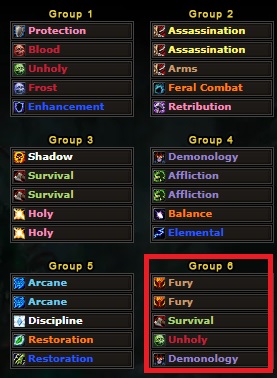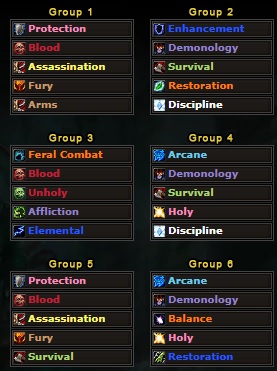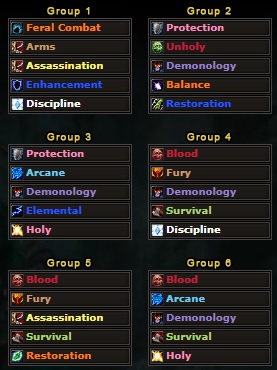Raid Composition Guide for Wrath of the Lich King Classic
In Wrath of the Lich King, all classes and specializations bring various buffs
and debuffs that can help their raid, such as ![]() Bloodlust and Paladin
blessings.
Bloodlust and Paladin
blessings.
Most buffs and debuffs can be brought by multiple classes, giving you a degree of choice on whom to bring to the raid.
In this guide we will be going over what an optimized setup for 25-man raids looks like when using a 30-man roster, breaking the roster down into three 10-man groups and further into six 5-man groups, in order to showcase how to split your guild into leveling / dungeon / small raid groups.
Phase 4 / Icecrown Raid Composition
A simple approach to a minmaxed raid composition for Phase 4 is to cover tanking and healing with the meta classes, ensure all raid buffs are brought and fill in the remaining slots with meta DPS.
A meta healing composition example is 1 Holy Paladin (2 for 25 man) plus 1 Discipline Priest, and if you are raiding 25 man you add a Restoration Druid and Restoration Shaman who can also play DPS on low healing encounters.
A meta tanking composition is 1 Protection Paladin and 1 Blood Death Knight, with the Death Knight having a good DPS off-spec.
DPS wise, Feral DPS Druids will be especially powerful for most guilds
as their DPS improves greatly with gear and they bring extra ![]() Rebirths and
Rebirths and
![]() Innervates, which are invaluable during progression. Affliction Warlock
are also very stackable and have great execute damage for fights such as Professor Putricide,
Blood-Queen Lana'thel, and Sindragosa. Most other DPS are not that far behind,
so always remember that the meta can only take you so far: bring the player,
not the class!
Innervates, which are invaluable during progression. Affliction Warlock
are also very stackable and have great execute damage for fights such as Professor Putricide,
Blood-Queen Lana'thel, and Sindragosa. Most other DPS are not that far behind,
so always remember that the meta can only take you so far: bring the player,
not the class!
25-man Raid Composition Advice Summary
You can find below a quick summary of our current recommendation for a 25-man raid, with swappable people for no-shows and specific fights in group 6:

This composition brings high DPS and has at least one of each class, making it easier to recruit for and gear.
10-man Raid Composition Advice Summary
Using the roster above as a baseline, we have created three optimized groups below: group 1 & group 2, group 3 & group 4, and group 5 & group 6. Take note that due to the tank and healer requirements, some players will have to swap specializations:

5-man Leveling or Dungeon Composition Advice Summary
With the initial raid roster as a baseline, you can either optimize for maximum group DPS or maximum group convenience which includes summons, crowd control options, and spreading out armor types to minimize wasting drops.
As making specific groups is mostly useful during the early rush to level up and get attuned, we will focus on convenience and loot-waste minimization with the group suggestions below:

Raid Composition Logic
The first thing to consider when assembling a good group setup is class balance among the three required roles: Tank, Healer, and DPS. While every class and spec brings valuable utility of some sort, a single member of that specialization is usually enough to achieve maximum benefit for the whole group.
This leaves three specializations as the most desirable to stack, with benefits that continue to increase for each new member in the raid:
- Warlocks — the best caster DPS in Wrath, scale very well with gear and group buffs, and provide multiple important buffs and utility themselves. Their high execute damage and ability to DPS without looking at the target will be especially useful against Yogg-Saron in Ulduar.
- Paladins are the strongest tanks and healers in Wrath, and you will want
multiple of them in order to cover all blessings and to have as many
 Hand of Protection /
Hand of Protection /  Hand of Freedom /
Hand of Freedom /
 Hand of Sacrifice /
Hand of Sacrifice /  Divine Sacrifice cooldowns as possible!
Divine Sacrifice cooldowns as possible! - Death Knights — the new class has three specializations, all of which
are extremely valuable for their unique buffs, high damage, and utility with
 Death Grip. While you are unlikely to bring four to a raid if you can
avoid it, it is good to ensure you always have at least 3 in a 25-man setting.
Death Grip. While you are unlikely to bring four to a raid if you can
avoid it, it is good to ensure you always have at least 3 in a 25-man setting.
Therefore, our setups focused on stacking these specializations, while bringing as many other unique buffs from other classes and specs as possible.
If you are interested in learning more about the ups and downs of each class and specialization in Wrath Classic, check the links below:
25-man Logic and Notes

Starting with the role setup, we want to have around 30 main raiders, split as follows:
- Between 2 and 4 Tanks, for subbing and small-group gameplay.
- Between 3 and 6 Healers, for tougher fights during progress.
- Between 15 and 20 DPS, which will fill the raid once tanks and healers are decided on a fight-by-fight basis.
Tanks should mostly be Paladins and Death Knights, with Paladins having the strongest utility and general survivability out of all tanks in Wrath and Death Knights making for great off-tanks with their strong and stackable DPS off-specs and high single-target threat generation capabilities.
Healers should include one of each class for gear optimization purposes
and added flexibility in the way heals are delivered. Once you are looking to
bring multiples of the same healer class, Holy Paladins are ideal. Besides having
infinite Mana with ![]() Divine Plea and
Divine Plea and ![]() Seal of Wisdom, they also
have the best tank healing in the game with
Seal of Wisdom, they also
have the best tank healing in the game with ![]() Beacon of Light and great
cooldowns such as
Beacon of Light and great
cooldowns such as ![]() Hand of Protection,
Hand of Protection, ![]() Hand of Sacrifice,
and
Hand of Sacrifice,
and ![]() Divine Sacrifice.
Divine Sacrifice.
The best DPS classes in Wrath depend on the encounter and phase, with Warlocks and Death Knights being strong throughout the whole expansion, Warriors and other pure Physical damage dealers becoming strong in the later phases when Armor Penetration is more readily available, and Shamans starting off strong but scaling worse than other classes over time.
10-man Logic and Notes

10-mans are simple, role-wise. You want 2 Tanks, 2 Healers and 6 DPS for each raid. Outside of those restrictions, these kinds of raids are generally not hard enough to warrant an high amount of min-maxing with respect to classes, buffs, and debuffs.
That being said, since we provided a 30-man roster setup in the previous sections, it only makes sense to explain how to best split it apart into three 10-man groups in order to maximize gear and the odds of every group successfully clearing.
Our original roster contains enough classes to ensure full coverage of all
crowd control requirements, at least one ![]() Death Grip, a
Death Grip, a ![]() Bloodlust
and Replenishment source in each group, as well as a Demonology Warlock
for
Bloodlust
and Replenishment source in each group, as well as a Demonology Warlock
for ![]() Create Healthstone, summons and spell power buff. The two Mages
were spread out for waters and portals, as well.
Create Healthstone, summons and spell power buff. The two Mages
were spread out for waters and portals, as well.
5-man Logic and Notes

5-mans are equally simple for roles; you want 1 Tank, 1 Healer and 3 DPS for each group.
Following the same logic as the 10-man groups and starting from the same setup, we rearranged the groups in order to make sure there is a Tank and a Healer in each, while ensuring the different armor types are as spread out as possible to minimize loot waste from unusable drops.
We also tried to keep groups focused on either Physical or caster DPS and
give melee DPS a Discipline Priest or Restoration Druid
for extra resource generation through ![]() Rapture and
Rapture and ![]() Revitalize.
Revitalize.
Finally, just as we did in the 10 mans, we spread out the Warlocks and Mages to maximize the amount of players they can support with their unique utility conveniences.
Changelog
- 03 Oct. 2023: Updated for Phase 4 and Icecrown Citadel.
- 01 Sep. 2022: Page added.
This guide has been written by Seksi, original vanilla player and multi-class player, currently playing on Gehennas Horde. You can find him on the Classic Shaman and Druid, as well as the Icy Veins Discord.
- One Month of Server-Renaming Rights Is on the Line in China’s PvP Event
- Group Finder and Dual Spec on Classic Era, Attunement and Arena Changes in TBC
- Burning Crusade Classic Anniversary Edition Pre-Patch Release Date and Character Transfers
- Titan Reforged’s 11 Phases Will Flip Classic Power Progression
- China’s Titan Reforged Realms Add Huge QoL Upgrades Western WoW Players Won’t See
- Armor Bonus Bug, Gold From old Expansions, and More: Mists of Pandaria Classic Hotfixes, October 31st
- New Challenge Mode Medal, Reworked Thunderforging: MoP Classic, The Thunder King PTR Development Notes, October 31st
- Hardcore WoW Just Got Much Harder With This New Game Mode